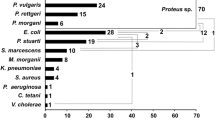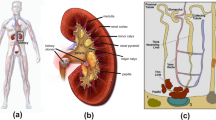Abstract
The aim of this study was to detect, isolate and characterize the nanobacteria from human renal stones from a north Indian population, and to determine their role in biomineralization. Renal stones retrieved from the kidneys of 65 patients were processed and subjected to mammalian cell culture conditions. The isolated bacteria were examined using scanning (SEM) and transmission electron microscopy (TEM). They were characterized for the presence of DNA, proteins and antigenicity. The role of these bacteria in biomineralization was studied by using the 14C-oxalate based calcium oxalate monohydrate (COM) crystallization assay. We observed the presence of apatite forming, ultrafilterable gram negative, coccoid microorganisms in 62% of the renal stones. SEM studies revealed 60–200 nm sized organisms with a distinct cell wall and a capsule. TEM images showed needle like apatite structures both within and surrounding them. They were heat sensitive, showed antibiotic resistance and accelerated COM crystallization. A potent signal corresponding to the presence of DNA was observed in demineralized nanobacterial cells by flow cytometry. The protein profile showed the presence of several peptide bands of which those of 18 kDa and 39kDa were prominent. Apatite forming nanosized bacteria are present in human renal stones and may play a role in the pathophysiology of renal stone formation by facilitating crystallization and biomineralization. However, further studies are required to establish the exact mechanism by which nanobacteria are involved in the causation of renal stones.








Similar content being viewed by others
References
Parks JH, Coe FL (1996) Pathogenesis and treatment of calcium stones. Semin Nephrol 16: 398
Menon M, Resnick MI (2002) Urinary lithiasis: etiology, diagnosis and medical management. In: Walsh PC, Retick AB, Vaughan ED, Wein AJ (eds) Campbell’s urology, 8th edn, vol 4. Saunders, Philadelphia p 3229
Brown CM, Purich DL (1992) Physical chemical process in kidney stone formation. In: Coe FL, Flames ML (eds) Disorders of bone and mineral metabolism. Ravan Press, New York p 613
Drach GW, Boyce WH (1972) Nephrocalculosis as a source for renal calculi: observation on humans and squirrel monkeys and on hyperparathyroidism in squirrel monkey. J Urol 107: 897
Kajander EO, Ciftcioglu N (1998) Nanobacteria: an alternative mechanism for pathogenic intra and extracellular calcification and stone formation. Proc Natl Acad Sci U S A 95: 8274
Ciftcioglu N, Bjorklund M, Kuorikoski K, Bergstrom K, Kajander EO (1999) Nanobacteria: nn infections cause for kidney stone formation. Kidney Int 56: 1893
Abbott A (1999) Battle lines drawn between Nanobacteria researchers. Nature 401: 105
Abbott A (2000) Researchers fail to find signs of life in living particles. Nature 408: 394
Drancourt M, Jacomo V, Hubert L, Lechevallier, Grisoni V, Coulange C, Ragni E, Claude A, Dussol B, Berland Y, Raoult D (2003) Attempted isolation of Nanobacterium sp. Microorganisms from upper urinary tract stones. J Clin Microbiol 41: 368
Cisar JO,Xu D-Q, Thompson J, Swaim W, Hu L, Kopecko DJ (2000) An alternative interpretation of nanobacteria—induced biomineralization. Proc Natl Acad Sci U S A 97: 11511
Collee JG, Meles RS,Watt B (1996) Tests for identification of bacteria. In: Collee JG, Fraser AG, Marurion BP, Simmons A (eds) Practical medical microbiology,14th edn. Churchill Livingstone, New York p 141
Ormerod MG (1990) Analysis of DNA. In: Ormerod MG (ed) Flowcytometry : a practical approach, 1st edn. Oxford University Press, Oxford p 69
Pak CYC, Ohata M, Holt K (1975) Effect of diphosphate on crystallization of calcium oxalate in vitro. Kidney Int 7: 154
Nakagawa Y, Ahmed MA, Hall SL (1987) Isolation from human calcium oxalate renal stones nephrocalcin, a glycoprotein inhibitor of calcium oxalate crystal growth. J Clin Invest 79: 1782
Laemmli UK (1970) Cleavage of the structural proteins during the assembly of the head of bacteriophage T4 Nature 227: 680
Ouchterlony O, Nilson LA (1986) Immunodiffusion and Immunoelectrophoresis. In: Weri DM (ed) Handbook of experimental immunology, 4th edn, vol 1. Blackwell Scientific, Oxford, pp 32.1–32.50
Hruska KA (2001) Nephrolithiasis. In: Schrier RW (ed) Diseases of the kidney, 7th edn, vol1, Lippincott William and Wilikins, Philadelphia p 789
Dewan B, Sharma M, Nayak N, Sharma SK (1997) Upper urinary tract stones and Ureaplasma urealyticum. Indian J Med Res 105: 15
Kajander EO, Kuronen I, Kari A, Alpo P, Ciftcioglu N (1997) Nanobacteria from blood, the smallest culturable autonomously replicating agent or earth. SPIE 3111: 420
Cuerpo EG, Kajander EO, Ciftcioglu N, Lovaco CF, Correa C, Gonzalez J, Mampaso F, Liano F, Garcia E, Escudero BA (2000) Nanobacteria: an experimental neo-lithogenesis model. Arch Esp Urol 53: 291
Hejelle JT, Miller HMA, Poxton IR, Kajander EO, Ciftcioglu N, Jones ML, Caughey RC, Brown R, Millikin PD, Darras FS (2000) Endotoxin and nanobacteria in polycystic kidney disease. Kidney Int 57: 2360
Kajander EO, Bjorklund M, Ciftioglu N (1998) Mineralization by nanobacteria. SPIE 3441: 86
Breitschwerdt EB, Sontakke S, Cannedy A, Hancock SI, Bradley JM (2001) Infection with Bartonella weisii and detection of nanobacterium antigens in north Carolina beef herd. J Clin Microbiol 39: 879
Bradbury J (1998) Nanobacteria may lie at heart of kidney stones. Lancet 352: 121
Towbin H, Stachelin T, Gordon J (1979) Electrophoretic transfer of proteins from polyacrylamide gels to nitrocellulose sheets: procedure and some applications. Proc Natl Acad Sci U S A, 76: 4350
Author information
Authors and Affiliations
Corresponding author
Additional information
An erratum to this article can be found at http://dx.doi.org/10.1007/s00240-012-0505-z
Rights and permissions
About this article
Cite this article
Khullar, M., Sharma, S.K., Singh, S.K. et al. Morphological and immunological characteristics of nanobacteria from human renal stones of a north Indian population. Urol Res 32, 190–195 (2004). https://doi.org/10.1007/s00240-004-0400-3
Received:
Accepted:
Published:
Issue Date:
DOI: https://doi.org/10.1007/s00240-004-0400-3




